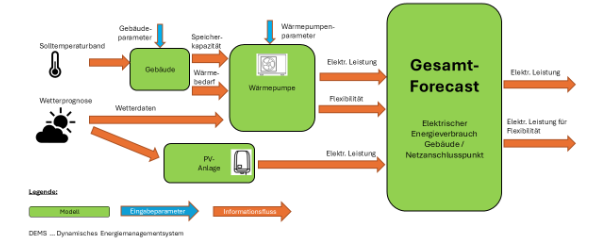FlexHP - AI-supported control models for optimising the flexibility of heat pumps to reduce the load on the electricity grid
Short Description
Starting point / motivation
As part of the European Union, Austria has set itself ambitious targets for climate neutrality. The building sector in particular accounts for a large proportion of domestic CO2 emissions, which is why a switch to renewable energy sources and an integrated heating transition with a switch to heat pumps is also necessary here.
The use of electricity from wind power and photovoltaics will increase massively so that heating and cooling in the building sector can take place sustainably and without CO2 emissions. This is accompanied by challenges that primarily affect the electricity grid. High feed-in peaks from renewables and a simultaneous lack of grid supply put a strain on the grid.
In view of this fact, the topics of energy storage, load shifting and sector coupling are becoming increasingly important. At the same time, the existing building stock offers us potential that is currently underutilised. This requires control systems that react proactively to changes and take measures in advance.
Artificial intelligence (AI) and the Internet of Things (IoT) have multiplied the potential for new control algorithms in recent years. Smart algorithms for intelligent control of individual consumers allow load shifting and can relieve the load on the electricity grid and increase the proportion of renewables in the grid.
Contents and goals
The aim of this project is to develop a new type of management tool for dynamic and flexible heat pump operation in a decentralised energy system (= dynamic energy management system DEMS). Heart of this DEMS are models of the various players in the system and an algorithm that optimises the energy flows.
Methods
One methodological focus is on modelling the actors in the energy system. Modern AI-based technologies are used for this, for example machine learning methods enables a holistic view of the building energy system, taking into account the share of renewable energies in the distribution grid, especially at the medium and low-voltage level. The focus of the modelling is on the development of a reliable heat pump model for forecasting power consumption in combination with the thermal behaviour of the building.
Finally, the individual models are combined in an overall forecast, which serves as the basis for controlling the energy flows. The figure shows the structure of the planned DEMS. The function of the data management system is being trialled in a living lab.
Expected results
The primary result is an experimentally confirmed concept for a dynamic energy management system that can be subjected to a broad test by means of functional verification on a laboratory scale. Testing in the Living Lab has largely eliminated challenges relating to interface incompatibility and the poor quality of the models and data.
The model structure is not specific to building types, which extends the field of application to various building uses and larger spatial structures such as urban neighbourhoods or entire cities. Finally, various application scenarios are identified for a possible expansion of the system beyond the Living Lab.
Project Partners
Project management
Universität für Bodenkultur Wien – Institut für Verfahrens- und Energietechnik
Project or cooperation partners
- Novotek Austria GmbH
- Wirtschaftsagentur Burgenland Forschungs- und Innovations Gmbh
Contact Address
DI Dr. Magdalena Wolf
Mutghasse 107
A-1190 Wien
Tel.: +43 (1) 47 654 89 315
E-mail: magdalena.wolf@boku.ac.at
Web: https://short.boku.ac.at/refrigeration

